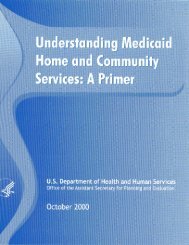STRATEGIC PLAN - ASPE - U.S. Department of Health and Human ...
STRATEGIC PLAN - ASPE - U.S. Department of Health and Human ...
STRATEGIC PLAN - ASPE - U.S. Department of Health and Human ...
You also want an ePaper? Increase the reach of your titles
YUMPU automatically turns print PDFs into web optimized ePapers that Google loves.
CHAPTER 6: Responsible Stewardship <strong>and</strong> Effective Managementthroughout the entire agency are aligned with the HHSmission <strong>and</strong> oriented toward achieving results. 18Effective Information Technology ManagementProvide a well-managed <strong>and</strong> secure enterpriseinformation technology environment. 19Development <strong>of</strong> a comprehensive plan that optimizesthe use <strong>of</strong> resources in support <strong>of</strong> all strategic <strong>and</strong>management goals <strong>and</strong> objectives. The Clinger-CohenAct <strong>of</strong> 1996 (Public Law 104-106) requires that everyFederal agency develop an Enterprise Architecture (EA).EA ensures that the business <strong>and</strong> technical architecturesfor the <strong>Department</strong> support the HHS mission <strong>and</strong>outcome objectives by establishing relationships between<strong>and</strong> among business operations <strong>and</strong> the informationsystems <strong>and</strong> resources that enable those operations. EAtakes a comprehensive view <strong>of</strong> the enterprise, includingstrategic planning, organizational development,relationship management, business processimprovement, information <strong>and</strong> knowledge management,<strong>and</strong> operations. EA will enable the <strong>Department</strong> toachieve more effective planning <strong>and</strong> control overinvestments for information technology by enhancingflexibility <strong>and</strong> interoperability across informationsystems; reducing redundancies; <strong>and</strong> improving access toaccurate, timely, <strong>and</strong> consistent information.Maintain a secure environment in which allaspects <strong>of</strong> security, privacy, <strong>and</strong> confidentialityare addressed. HHS is an attractive high-pr<strong>of</strong>iletarget for hackers <strong>and</strong> those with malicious intentseeking sensitive medical information, homel<strong>and</strong>security first responder information, patent <strong>and</strong>intellectual property worth billions <strong>of</strong> dollars, <strong>and</strong>much more. In order to address these immediatechallenges <strong>and</strong> comply with Federal legislation, HHShas developed a proactive, enterprisewide informationtechnology (IT) security program (Secure One HHS)to help protect the HHS IT infrastructure againstpotential threats <strong>and</strong> vulnerabilities. The Secure OneHHS IT Security Program was designed to increase the18 Appendix C, Performance Plan Linkage, provides additionalinformation on these strategies.19 Additional information about HHS’s information technologystrategies is included in the Information Technology section.baseline IT security posture across all HHS operatingdivisions while reducing reporting burdens forcompliance with Federal m<strong>and</strong>ates. The creation <strong>of</strong>this new security program, which spans the HHS ITcommunity, Headquarters, <strong>and</strong> the operating divisions,is an important step in protecting HHS’s ability toprovide mission-critical services <strong>and</strong> maintain thepublic’s trust <strong>and</strong> confidence in the quality <strong>of</strong> HHSservices <strong>and</strong> business operations.Manage information technology projects <strong>and</strong>investment to demonstrate results <strong>and</strong> consistentlyprovide the value intended. This activity will requirethe successful completion <strong>of</strong> all aspects <strong>of</strong> project <strong>and</strong>investment management rigor that are described in theHHS Enterprise Performance Life Cycle (the integration<strong>of</strong> management, business, <strong>and</strong> engineering life-cycleprocesses that span the enterprise to align IT with thebusiness). This success will be measured by the HHSCapital Planning <strong>and</strong> Investment Control process, whichstructures budget formulation <strong>and</strong> execution, ensuresthat investments consistently support the strategicgoals <strong>of</strong> the agency, <strong>and</strong> includes the evaluation <strong>of</strong>effective earned value management.Effective Resource ManagementUse financial <strong>and</strong> capital resources appropriately,efficiently, <strong>and</strong> effectively.Ensure the integrity <strong>of</strong> HHS financial managementprocesses. Financial management systems thatmeet Joint Financial Management ImprovementPlan certification st<strong>and</strong>ards will be in place<strong>Department</strong>wide by 2010, with all but Medicare PartsC <strong>and</strong> D covered by the beginning <strong>of</strong> FY 2010. HHSalso will address all identified outst<strong>and</strong>ing materialweaknesses <strong>and</strong> internal control deficiencies.Manage financial resources wisely <strong>and</strong> appropriatelythrough the reduction <strong>of</strong> improper payments.According to the Improper Payments InformationAct <strong>of</strong> 2002 (Public Law 107-300), improper paymentsoccur when funding is provided to the correct recipientin the incorrect amount, when the wrong recipientreceives funds, or when funds are used by the recipientimproperly. HHS will continue its efforts to reducethe rates <strong>of</strong> improper payment in three <strong>of</strong> its largest136 HHS Strategic Plan FY 2007-2012
















